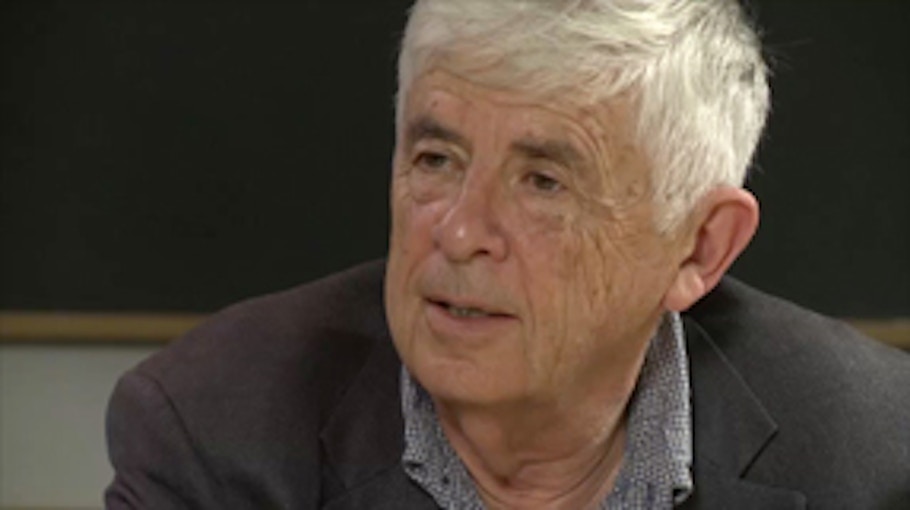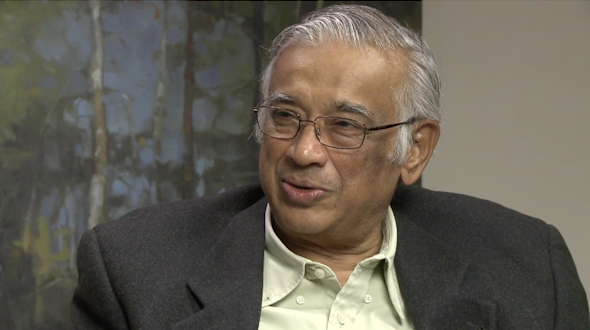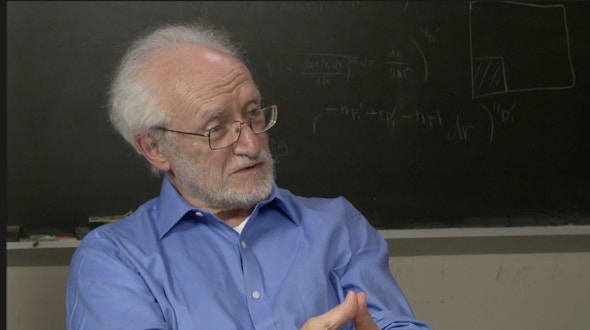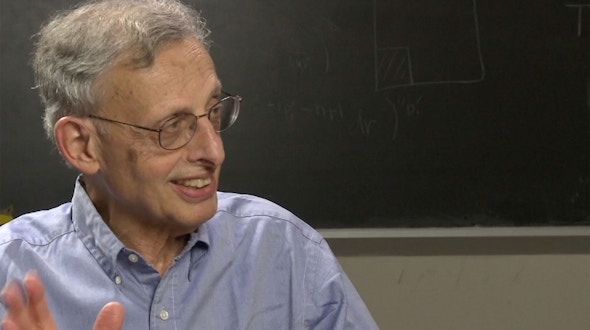Alexandre Chorin
- Highlights (2:11)
- Early Life and Education (6:01)
- Return to Israel (3:35)
- Attending the Courant Institute (5:45)
- Early Work at Courant (4:16)
- Early Work on Projection Method (5:03)
- Projection and Vortex Methods (3:06)
- Introduction to Raising Reynolds Number (4:00)
- Coming to Berkeley (5:29)
- Turbulence (4:08)
- Large Scale Computing (3:36)
- Statistical Mechanics and Turbulence (2:25)
- Sampling Data Assimilation Spins (1:35)
- Doing Applied Math at Berkeley (1:29)
- The Future of Computational Mathematics (2:15)
- The Lawrence Berkeley Lab (1:24)
- Applied and Computational Mathematics at Berkeley (4:33)
- Working with Students (3:47)
- Vortex Methods and Turbulence (9:09)
- Understanding Turbulence Through Data (8:57)
- Understanding Turbulence (8:02)
- Partial Data Sampling and Data Assimilation (8:21)
- Courant was a Magical Place (3:20)
- Colleagues and Students at Berkeley (5:53)
- Teaching at Berkeley (7:15)
Turbulence — a phenomenon epitomized by the churning, swirling and spraying waters of Niagara Falls — remains beyond mathematical understanding. But when the flow of liquids and gases slows and they become more viscous, mathematicians who study fluid mechanics are much more adept at conceptualizing what is happening, thanks in good part to the work of Alexandre Chorin, a math professor at the University of California, Berkeley. Over the course of his 50-year career, this pioneer in computational math has helped the field evolve from one in which researchers used the computer like a huge abacus to one in which they routinely apply powerful machines to solve problems once considered hopelessly complex. Along the way, he has trained dozens of doctoral students who have advanced the field even further.
Just as Chorin succeeded in taming the field of fluid mechanics only when turbulence was out of the picture, his life and career took off only after he had weathered a certain degree of turmoil. He was born in 1938 into one of the most unstable, dangerous situations imaginable: a Jewish family in Poland on the eve of World War II. His father was an industrialist and his mother, a judge. When Germany invaded Poland a year later, his immediate family, along with three other relatives, managed to make its way through the Soviet Union, ending up, after two years, in the British mandate of Palestine. There, Chorin’s life stabilized for a time, and he began to explore the world of math under the guidance of a distant relative, who presented five-year-old Alexandre with math puzzles, taught him some geometry and even introduced him to negative numbers. In Chorin’s recollection, this relative told him he was good at math and should become a mathematician. That became his goal by age eight. Two years later, his school placed him in a program for gifted students, and it planned to enroll him in a special mathematics program.
Before that could happen, however, another upheaval shook Chorin’s life. In 1950, his family left what had become the new nation of Israel to take up residence in Switzerland, where his father had business dealings. Chorin, now entering adolescence, was adamant about not wanting to live there. He says that, coming from Israel and hearing for years about the Holocaust and dead relatives, “I thought at the time that doing homework was collaboration with the enemy” (despite the fact that Switzerland was officially neutral during the war, and his German homeroom teacher was “actually a very nice lady”). His high-school grades suffered in consequence, and the private school forced him to leave at the end of his junior year and take the exam for an equivalency diploma.
Chorin still wanted to study math — pure math, in particular — but his grades seemed to preclude that option. So he applied to the École Polytechnique Fédérale de Lausanne to study mechanical engineering, a subject he considered close to mathematics that also dovetailed with his interest in airplanes. His most consequential experience at the school was his acquaintance with famed geometer Georges de Rham, whose courses he took and for whom he became a grading assistant. “To a very large extent, I owe the fact that I became a mathematician to de Rham,” Chorin says. But first came an equally consequential interlude in Israel, to which he returned upon graduating from college in 1961.
Chorin expected to be drafted into the military. But he wasn’t, because of what he calls complicated negotiations with the authorities. Instead, he was sent to the Weizmann Institute of Science, in Rehovot, to work for a year with Chaim Pekeris, an early computational physicist. In his new job, Chorin largely taught himself how to program the institute’s huge, vacuum-tube-filled computer. Programming in those days involved feeding perforated paper tapes containing programs into the machine and reading the tapes by holding them up to the light. The work was arduous and slow, but Chorin fell in love with it. “I truly got a kick out of the calculations Pekeris was doing,” he remembers. Pekeris’ modus operandi, which Chorin adopted, was to start with a concrete physics problem, apply some math to it, do some programming and — voilà! — get an answer. The experience steered him toward applied math and established an approach that, Chorin says, “I’ve stuck to ever since.”
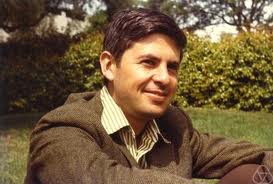
Upon returning to Switzerland, Chorin wanted to attend graduate school but had trouble deciding where to apply. In a fateful chance encounter on the street, he met his former teacher, de Rham, who advised him to pick a school in the United States and wrote letters on his behalf. De Rham counseled him, in particular, to study with another famous mathematician, Peter Lax, at New York University’s Courant Institute. Courant was then what Chorin calls the “mother ship” of computational and applied math. It accepted him as a doctoral candidate, and he moved to New York, a city that greatly appealed to him. Greenwich Village, where the institute is located, was then in its heyday, boasting coffeehouses and jazz clubs with famous entertainers. Chorin is an opera aficionado, and the city then had two major opera companies.
Lax, now 87 and a professor emeritus at Courant, recollects being initially drawn to Chorin because of a misunderstanding. Lax thought that Chorin was a fellow Hungarian emigré because there was a very prominent family named Chorin in Hungary. But Chorin’s original Polish surname was Choroszczański; the family had changed it in Israel. (In contrast, he never Anglicized his French first name because he wanted to avoid being confused with another fluid-mechanics researcher whose first name was “Alexander” and whose surname was similar to Chorin.)
Even though Chorin turned out not to be Hungarian, Lax recounts that once he got to know him, “I thought highly of him. He had a very lively mind.” Lax also notes that Chorin “was always very independent.” Chorin’s doctoral thesis was about thermal inversion, an atmospheric condition that occurs when warm, often polluted, air is trapped at ground level; normally the air should rise. “The weather office was trying to predict when you have thermal inversion by measuring the temperature at different heights and trying to check what the gradient was,” Chorin says. “And the results surprised them. They wanted to understand what the dynamics of the thermal conduction were. At that time, it was becoming possible to compute it, so that’s what I did for my thesis.”
He also accomplished his best-known work in his thesis and in two years as a Courant postdoc: the first general method to solve the Navier-Stokes equations, named after a physicist and a mathematician who lived in the nineteenth century. These complicated nonlinear partial differential equations describe the motion of fluid substances. So how did Chorin solve them on a computer, a machine that only adds, subtracts, multiplies and divides? “There are a number of ways of doing that,” he explains. “But one of them is if you transform a one-line differential equation into a colossal set of algebraic equations, which you can only solve with a computer.” Without a computer, the equations remain unsolvable except in special cases.
Chorin’s Navier-Stokes solution uneasily straddled the divide between mathematicians, who want to prove theorems, and scientists and engineers, who want to solve physical problems. In fact, the first engineers to look at the solution didn’t accept it, Chorin recalls, because “it looked to them impossibly abstract and unintuitive.” And “a pure mathematician might say you’re still not solving [the Navier-Stokes equations] because it’s only approximate,” notes Charles Peskin, a math professor at Courant and a former student of Chorin’s (one of three elected to the National Academy of Sciences). Chorin agrees that his solution was not a mathematical proof, stressing that “I don’t prove things; I calculate.”
Peskin nevertheless calls Chorin’s approach “incredibly useful.” Peskin has used it as a springboard for studying coronary blood flow and designing artificial heart valves. It has also led to the design of better aircraft and combustion engines, to cite just two — of many — applications.
In addition to serving as the jumping-off point for Chorin’s research career, Courant was also where he began to teach after he became an assistant professor. “I’m not naturally a good teacher, at least not in a classroom,” he says. “I speak too fast, and I cover too much material.” But Peskin, who took Chorin’s fluid-mechanics course, disagrees, remembering him as “terrific in the classroom.”
There is no doubt, at least, about Chorin’s superior skills as an adviser. He has shepherded about 50 students to their doctoral degrees, a higher number than average. “He was very supportive and encouraging,” recalls Phillip Colella, a senior scientist in computational research at Lawrence Berkeley National Laboratory who studied with Chorin in the 1970s. (He was Chorin’s second doctoral student to be elected to the National Academy of Sciences; James Sethian, who conducted the interview accompanying this article, was the third.) About 30 of Chorin’s former graduate students came from all over the United States to attend his 60th birthday party, where each also gave a 10-minute talk. At the three-day affair, “the level of both affection and respect for him was palpable,” says Colella.
Chorin left Courant for Berkeley in the early 1970s, and he’s been a faculty member there ever since. He made the move for several reasons: He wanted to be more independent; he wouldn’t have to compete for graduate students with as many famous applied mathematicians; and he would be close to more potential research collaborators (unlike Berkeley, NYU lacks an engineering school). “I’ve been very happy in Berkeley, in particular, because I found so many people to collaborate with,” he says.
Chorin has become something of an institution at Berkeley and at Lawrence Berkeley National Laboratory, where he also works. Though he is officially retired, he still conducts research and does computer programming at both institutions. In 2002, he became a University Professor – a title reserved for “scholars of international distinction who are recognized as teachers of exceptional ability,” according to the University of California Web site; he’s one of just 24 such professors in the entire University of California system. And in 2008, Chorin was one of two faculty members to receive Berkeley’s Sarlo Distinguished Graduate Student Mentoring Award.
Chorin has also taught undergraduate courses, and before classes, he would sit in front of the building and dispense advice to students and their families who approached him. A peacenik in matters of Israeli politics, he once tried to persuade a Palestinian man that it was okay for his son to undertake a thesis with an Israeli. That piece of advice wasn’t accepted.
The focus of Chorin’s research has evolved during his 40-plus years at Berkeley. His initial work in fluid mechanics led him to study one of its subfields: turbulence. But turbulence continues to elude better understanding, he says, because it involves the mixture of a disorderly system and a non-disorderly system. Mathematicians can deal with each kind of system individually, just not a mixture. For the past decade, Chorin has worked on problems in data analysis, data simulation and the estimation of uncertainty. His third book, “Stochastic Tools in Mathematics and Science,” co-authored with Ole Hald, came out about eight years ago and is in its third edition.
Hald has known Chorin for well over 40 years — ever since Hald was a Ph.D. student at the Courant Institute, when Chorin (who was not his advisor) steered him toward his thesis topic. For 20 years, when they lived a few houses apart, they took evening strolls together, initially to walk Chorin’s dog, and talked about practically everything under the sun. Hald, now a math professor at Berkeley, still can’t believe the range of Chorin’s interests, which, in the arts alone, extend from classical Greek literature to the modern opera “Einstein on the Beach” by Philip Glass. “One never quite understands how he is capable of reading so much and being so incredibly well informed,” Hald marvels. In light of Chorin’s outsize role in the field of computational math, it might indeed be appropriate to liken his information-processing capabilities to those of his tool of choice, the computer.
